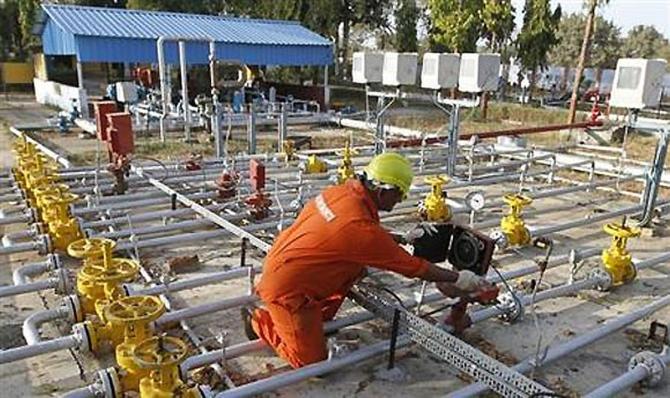While India’s dependence on imported oil and gas is rising steadily, the country’s premier exploration conglomerate’s share of domestic natural gas production is less than 80 per cent, that of oil is far lower at 66.3 per cent.

It is rare for Cabinet ministers to tick off state-owned companies publicly, yet that was what then petroleum and natural gas minister Dharmendra Pradhan did for ONGC.
Speaking at an event on June 29, Pradhan said he has asked
India’s premier exploration company to find fresh oil acreages fast.
“Do it yourself through some joint venture (or) through a new business model. But the government cannot permit you to hold resources for an indefinite time.”
The reason for this stricture is India’s rising dependence on imported oil and gas.
Or, to put it another way, falling domestic production (see chart: “Crude truth”), especially from ONGC, which faces a simple problem.
A reply in Parliament shows ONGC’s share of domestic natural gas production is less than 80 per cent, that of oil is far lower at 66.3 per cent.
Analysts peg the per barrel cost at ONGC well-head at $50, which is incredibly high by global standards, which is less than $20.
It can still plod on thanks to high global prices — ranging above $70 a barrel (Brent crude), if not gas.
In June this year, S&P Global Ratings assigned an improved earnings outlook for the next 12-18 months for the company (BBB-/Stable) on this account.
Way before Pradhan waded into the debate publicly, the ministry had advised ONGC to sell stakes in oil fields such as the Ratna R-Series as part of efforts to monetise infrastructure to raise cash flows.
These are medium-sized offshore fields in the south-west of Mumbai.
They cost about Rs 472 crore for ONGC to develop in 1983 but production stopped in 1994 because it became uneconomic.
There was an in-principle decision made at that time to auction them but has never got done.
In a letter written in April this year and signed by Amar Nath, additional secretary in the petroleum and natural gas ministry, the company was advised to hive off its drilling and other services into a separate firm.
Nath sits on the ONGC’s board as one of two government nominees, representing its 60.56 per cent shareholding.
That he had to send such a mail means the company board is unable to take decisions.
The board still lacks a full-time chairman.
Subhash Kumar, director (finance), is holding additional charge as chairman and managing director.
The Public Enterprises Selection Board has tried for over a year.
In the latest beauty parade of nine contestants it found no suitable candidate.
So ONGC will remain headless until the board puts up a fresh advertisement for the post.
Thus, ONGC is a company without a clear road map for the future despite its board adopting Energy Strategy 2040 two years ago.
It wants to move up the value chain to concentrate on areas where the expected risk-reward payoff offers better growth opportunities, such as aromatic petrochemicals, gas-based power plants and, finally, into renewables.
Except in the first, the company is not a leader in any of the sectors nor does it occupy the number two slot.
At the current scale of expansion, it does not seem to have the ambition to be so.
The ministry itself is, therefore, not sold on this strategy.
The company was born before the high noon of oil sector nationalisation in West Asia, and became India’s flag bearer for energy security.
Mumbai High Field (formerly Bombay High) was its best strike in 1974.
Since then, India has become the world’s third-largest oil consumer and the demand-supply equation has changed.
The company is caught in a low flying orbit.
As S&P notes, ONGC will maintain prudent capital investments over fiscal 2022, to invest in existing well and a new discovery in Ashoknagar off the Bengal coast, largely funded with operating cash flows and an encouraging rate of return of 9 per cent, higher than most global peers.
But those numbers are modest at about Rs 43,000 crore in FY21, down from close to Rs 55,000 crore the previous year.
It was making the same sort of investments in FY16.
For comparison, Sinopec China has an exploration budget more than four times of ONGC’s (see table: “Off the map”).
The S&P Platts table shows in the league of global oil and gas exploration companies ranked by assets the company is fairly puny.
RIL, too, is three times ONGC’s size.
The company does not have the money to blow up in high-risk wells. But all of India’s new finds are high risk.
The Indian subcontinent is not only geologically dry for both oil and gas, it makes the little pockets of discoveries impossibly costly, when the world is sitting on massive un-utilised reserves.
ONGC’s future as an explorer is unclear if it does not have the money to explore.
It is one of the reasons its share price languishes.
The company has declared 10 discoveries in its operating averages in FY21.
Its best recent find, the Ashoknagar well in the Bengal basin, discovered in 2018, will take years of investment before it reaches commercial production.
Meanwhile, for each find, it has to figure out offsetting ways to reduce its carbon footprint, according to the ministry’s latest guidelines, to be “completely sustainable and carbon neutral”.
When it comes to gas, even here, the company, despite a promising start a few decades ago, has lost leadership.
It is constrained by low administered prices and acknowledges this problem publicly.
In a note to the stock exchanges, it says: “Despite uneconomical gas prices, ONGC has been aggressively pursuing its deep-water projects in East Coast and a couple of shallow water projects in West Coast…There are certain issues around structure where decisive steps can be evaluated only once the industry is completely under GST regime”.
Though it is unlikely that the Centre will accede to Assam Chief Minister Himanta Biswa Sarma’s request to consider transferring all the assets of ONGC in the Northeastern region to Oil India, the sense of loss of direction is clear.
It might be better if the company were to just import gas or even oil.
Its subsidiary ONGC Videsh already has a product pipeline that is 32.34 per cent of ONGC’s domestic production in FY19.
ONGC as a trading company could realise more value than digging up dry wells.
Photograph: Amit Dave/Reuters










